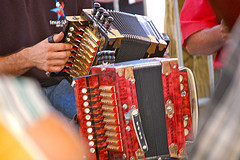
flic.kr/p/8MGjvg
For long years, Cajun accordion has been popular throughout the world as one of the interesting, fun to play type of reeds. Stories have been said that this instrument is actually by origin and definition as “melodeon”, meaning an instrument with fundamentally melodic potential, incompletely supported by tow simple harmonies. In fact, this is also the reason that many people call it the Melodeon.
The History
The Cajun accordion or melodeon is actually a small diatonic accordion initially made in Germany in the second half of the nineteenth century. It has been commonly noted that the first instruments available during that time bear the trademarks Bruno, Lester, and Pine Tree. These instruments had the inconvenience of being pitched in A or F, which are keys basically impossible to accompany on the fiddle. Soon after, not until the dawn of this century that Buegeleisen & Jacobson of New York brought in the Monarch and the Sterling in C and D. The Cajuns then nicknamed them “Tits Noirs” meaning “Little Blacks” on account of their color and size. These later on became the Cajun accordions and they required a great reputation, justified by the high quality and reliability of their reeds.
Physical Features
As a small diatonic instrument, the Cajun accordion features a one-row keyboard with 10 buttons on the right hand treble side. Each button controls two notes according to the motion of the bellows, whether they are pulled outwards or pushed inwards. The Cajuns name this as the “single action”. In addition, the Cajun accordion also has four stops on the right hand casing which bring into action four banks of reeds tuned in octaves associated to each other. It is crucial to note that the different banks of reeds in Cajun accordion are tuned in perfect octaves known as “dry” tuning.
On the left side of the Cajun accordion, there is a keyboard in the form of a hand-grip. This keyboard has two buttons providing respectively two bass notes as well as two chords. Also, the keyboard on the left side offer an air button for the thumb which enables the rapid opening or closing of the bellows during the play.
Strengths of Cajun Accordion
Compared with the fiddle, the Cajun accordion is extremely noted for its superb reliability and robustness. It has four reeds for each note. Therefore, even if some were broken during the play, there are others that are enough to make music. Additionally, this is also the only instrument which could endure the humidity of any region. The Cajun accordion only require minimum maintenance and was easily repairable. Finally, it was fully in tune and ready to play while the section of the basses efficiently backed up the melody and offer a fullness as well as resonant power which could not be matched by the fiddle.
Tagged with: history of accordion • types of accordion
Filed under: Accordion